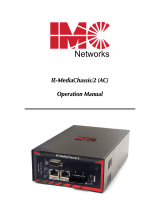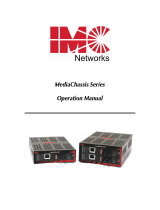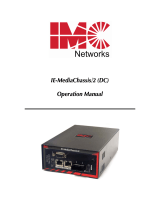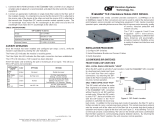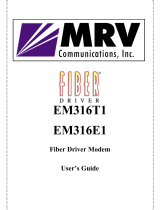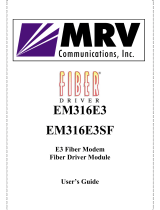Page is loading ...

iMcV-T1/E1/J1
Operation Manual

FCC Radio Frequency Interference Statement
This equipment has been tested and found to comply with the limits for a Class B computing device, pursuant to Part 15 of the FCC Rules.
These limits are designed to provide reasonable protection against harmful interference when the equipment is operated in a commercial
environment. This equipment generates, uses and can radiate radio frequency energy and, if not installed and used in accordance with the
instruction manual, may cause harmful interference to radio communications. Operation of this equipment in a residential area is likely to
cause harmful interference in which the user will be required to correct the interference at his own expense.
Any changes or modifications not expressly approved by the manufacturer could void the user’s authority to operate the equipment.
The use of non-shielded I/O cables may not guarantee compliance with FCC RFI limits. This digital apparatus does not exceed the Class B
limits for radio noise emission from digital apparatus set out in the Radio Interference Regulation of the Canadian Department of
Communications.
Le présent appareil numérique n’émet pas de bruits radioélectriques dépassant les limites applicables aux appareils numériques de classe B
prescrites dans le Règlement sur le brouillage radioélectrique publié par le ministère des Communications du Canada.
Warranty
IMC Networks warrants to the original end-user purchaser that this product, EXCLUSIVE OF SOFTWARE, shall be free
from defects in materials and workmanship under normal and proper use in accordance with IMC Networks' instructions
and directions for a period of six (6) years after the original date of purchase. This warranty is subject to the limitations set
forth below.
At its option, IMC Networks will repair or replace at no charge the product which proves to be defective within such
warranty period. This limited warranty shall not apply if the IMC Networks product has been damaged by unreasonable
use, accident, negligence, service or modification by anyone other than an authorized IMC Networks Service Technician
or by any other causes unrelated to defective materials or workmanship. Any replaced or repaired products or parts carry
a ninety (90) day warranty or the remainder of the initial warranty period, whichever is longer.
To receive in-warranty service, the defective product must be received at IMC Networks no later than the end of the
warranty period. The product must be accompanied by proof of purchase, satisfactory to IMC Networks, denoting
product serial number and purchase date, a written description of the defect and a Return Merchandise Authorization
(RMA) number issued by IMC Networks. No products will be accepted by IMC Networks which do not have an RMA
number. For an RMA number, contact IMC Networks at PHONE: (800) 624-1070 (in the U.S and Canada) or (949) 465-
3000 or FAX: (949) 465-3020. The end-user shall return the defective product to IMC Networks, freight, customs and
handling charges prepaid. End-user agrees to accept all liability for loss of or damages to the returned product during
shipment. IMC Networks shall repair or replace the returned product, at its option, and return the repaired or new
product to the end-user, freight prepaid, via method to be determined by IMC Networks. IMC Networks shall not be
liable for any costs of procurement of substitute goods, loss of profits, or any incidental, consequential, and/or special
damages of any kind resulting from a breach of any applicable express or implied warranty, breach of any obligation
arising from breach of warranty, or otherwise with respect to the manufacture and sale of any IMC Networks product,
whether or not IMC Networks has been advised of the possibility of such loss or damage.
EXCEPT FOR THE EXPRESS WARRANTY SET FORTH ABOVE, IMC NETWORKS MAKES NO OTHER WARRANTIES,
WHETHER EXPRESS OR IMPLIED, WITH RESPECT TO THIS IMC NETWORKS PRODUCT, INCLUDING WITHOUT
LIMITATION ANY SOFTWARE ASSOCIATED OR INCLUDED. IMC NETWORKS SHALL DISREGARD AND NOT BE
BOUND BY ANY REPRESENTATIONS OR WARRANTIES MADE BY ANY OTHER PERSON, INCLUDING EMPLOYEES,
DISTRIBUTORS, RESELLERS OR DEALERS OF IMC NETWORKS, WHICH ARE
INCONSISTENT WITH THE WARRANTY SET FORTH ABOVE. ALL IMPLIED WARRANTIES INCLUDING THOSE OF
MERCHANTABILITY AND FITNESS FOR A PARTICULAR PURPOSE ARE HEREBY LIMITED TO THE DURATION OF THE
EXPRESS WARRANTY STATED ABOVE.
Every reasonable effort has been made to ensure that IMC Networks product manuals and promotional materials
accurately describe IMC Networks product specifications and capabilities at the time of publication. However, because of
ongoing improvements and updating of IMC Networks products, IMC Networks cannot guarantee the accuracy of printed
materials after the date of publication and disclaims liability for changes, errors or omissions.
ii

Table of Contents
FCC Radio Frequency Interference Statement ....................................................ii
Warranty............................................................................................................ii
About the iMcV-T1/E1/J1 ...................................................................................4
Contents ............................................................................................................4
Prerequisites ......................................................................................................4
Configuration .....................................................................................................5
Installation .........................................................................................................7
Description of DIP Switch-Selectable Options ..................................................11
Testing .............................................................................................................15
Specifications...................................................................................................19
Safety Certifications..........................................................................................20
iii

About the iMcV-T1/E1/J1
The iMcV-T1/E1/J1™ chassis mounted media conversion module allows you to
extend the distances between T1, J1, and E1 copper telephony systems by adding a
fiber segment. The distances you can add range from 2km to 100km depending on
the module used and the fiber type available.
Contents
This box contains the following items:
•
1 - iMcV-T1/E1/J1 Module
•
1 - Operation Manual
Prerequisites
Before you install the iMcV-T1/E1/J1 modules, perform the following:
•
Make sure you have the correct modules for your fiber type and your distance
requirements.
•
Make sure that T1 UTP lines
DO NOT
use simplex power (no wet lines).
•
Before you install the iMcV-T1/E1/J1 modules you must verify the DIP switches
are configured for the feature wanted.
•
Make sure you deploy the iMcV-T1/E1/J1 modules in pairs.
•
Make sure the Remote Chassis is not managed.
NOTE
The iMcV-T1/E1/J1 modules are delivered pre-configured for standard T1
operation in Passive mode. To enable remote management you must move DIP
switch S2-2 to the “ON” position on the Remote module (refer to the DIP switch
diagram and table).
4

Configuration
The iMcV-T1/E1/J1 module is factory-configured to use the following default features:
•
T1/E1 Mode....................................................................................................
T1
•
Receive Equalizer Gain Limit (EGL)
: .......................-30 dB (Limited Long Haul)
•
Line Encoding
: .................................................................... AMI (Passive Mode)
•
Transmit LIU Waveshape (Build-out)
: ................ DSX-1 (0 to 133 ft) 0 dB CSU
•
Receive LIU Termination
:................................ Receive Side 100 ohms Enabled
•
Transmit Data Source
: ................................................................Standard Data
•
Jitter Attenuator Select
: ................................. Place Jitter Attenuator on TX Side
•
Remote Management
: .......................................Remote Management Disabled
•
Loopback Selection
: ..................................................................... No Loopback
•
Monitor/Boost Mode
: ..........................................................................No Boost
•
NRZ Selection
:....................................................... Disable NRZ (Passive Mode)
You can use the iView
2
management software to change some of the
iMcV-T1/E1/J1 features after installing the modules in the chassis. Refer to the iView
2
online help for more information.
Passive Mode
It is recommended that you use the default Passive mode configuration for most
typical applications. Passive mode allows the fiber segment to pass data unchanged
between the T1/E1 segments independent of the actual line coding (AMI, B8ZS, or
HDB3). All errors and fault conditions from one T1/E1 end will pass through the fiber
to the other end as if there were one long T1/E1 connection.
5

Available configurations enabled by DIP switches (and iView
2
):
T1 Mode Configurations (default)
•
Receive Equalizer Gain Limit (EGL)
iView
2
o
-36 dB (Long Haul)
o
-30 dB (Limited Long Haul) (default)
•
Line Encoding
iView
2
o
B8ZS
o
AMI (default)
•
Transmit LIU Waveshape (Build-out)
o
DSX-1 (0 to 133 ft) 0 dB CSU (default)
o
DSX-1 (133 to 266 ft)
o
DSX-1 (266 to 399 ft)
o
DSX-1 (399 to 533 ft)
o
DSX-1 (533 to 655 ft)
o
-7.5 dB CSU
o
-15 dB CSU
o
-22.5 dB CSU
•
Receive LIU Termination
o
Receive Side Termination Disabled
o
Receive Side 120 ohms Enabled
o
Receive Side 100 ohms Enabled (default)
o
Receive Side 75 ohms Enabled
•
Transmit Data Source
iView
2
o
Standard Data (default)
o
Transmit Pseudorandom Bit Sequence
o
Transmit Alternating Ones and Zeros
o
Transmit Unframed All Ones
•
Jitter Attenuator Select
o
Place Jitter Attenuator on RCV Side
o
Place Jitter Attenuator on XMT Side (default)
•
Remote Management
o
Remote Management Enabled
o
Remote Management Disabled (default)
•
Loopback Selection
iView
2
o
No Loopback (default)
o
Fiber Analog Loopback
o
Fiber Digital Loopback
o
Twisted Pair Digital Loopback
•
Monitor/Boost Mode
o
No Boost (default)
o
20 dB
o
26 dB
o
32 dB
•
NRZ Selection
iView
2
o
Disable NRZ (default)
o
Enable NRZ
E1 Mode Configurations
•
Receive Equalizer Gain Limit (EGL)
iView
2
o
-12 dB (Short Haul)
o
-43 dB (Long Haul)
•
Line Encoding
iView
2
o
HDB3
o
AMI
•
Transmit LIU Waveshape (Build-out)
o
75 ohms
o
125 ohms
o
75 S ohms w/ High Return Loss
o
125 S ohms w/ High Return Loss
•
Receive LIU Termination
o
Receive Side Termination Disabled
o
Receive Side 120 ohms Enabled
o
Receive Side 100 ohms Enabled
o
Receive Side 75 ohms Enabled
•
Transmit Data Source
iView
2
o
Standard Data
o
Transmit Pseudorandom Bit Sequence
o
Transmit Alternating Ones and Zeros
o
Transmit Unframed All Ones
•
Jitter Attenuator Select
o
Place Jitter Attenuator on RCV Side
o
Place Jitter Attenuator on XMT Side
•
Remote Management
o
Remote Management Enabled
o
Remote Management Disabled
•
Loopback Selection
iView
2
o
No Loopback
o
Fiber Analog Loopback
o
Fiber Digital Loopback
o
Twisted Pair Digital Loopback
•
Monitor/Boost Mode
o
No Boost
o
20 dB
o
26 dB
o
32 dB
•
NRZ Selection
iView
2
o
Disable NRZ
o
Enable NRZ
6

Installation
At the central location the iMcV-T1/E1/J1 unit is typically installed in a managed
chassis such as the
iMediaChassis
or the
iMediaCenter
.
iMediaChassis
iMediaCenter
7

MediaChassis
The MediaChassis provides a typical unmanaged chassis suitable for all remote
installation locations.
NOTE
Chassis may also be available in Industrial Ethernet (IE) configurations.
Each module requires one slot in the chassis. To install a module, remove the blank
brackets covering the slots where the module is to be installed (if present) by
removing the screws on the outside edges of the bracket. Slide the module into the
chassis, via the card guides, until the module is seated securely in the connector.
Secure the module to the chassis by tightening the captive screw. Save any “blanks”
removed during installation for future use should your configuration requirements
change.
Crossover/Straight-Through Connection
iMcV-T1/E1/J1 comes with an RJ48 UTP connector that features a push-button
switch, located next to the port, for selecting a crossover workstation or straight-
through connection. To select a cross-over connection, press the push-button IN. A
straight-through connection is selected when the push-button is OUT. When unsure
what type of connection you need, set the push button to the position that turns the
NO LNK LED off.
8

DIP Switch Table
T1/E1 Selection
S2-1: OFF T1 Mode Selected default
S2-1: ON E1 Mode Selected
Receive Equalizer Gain Limit (EGL)
E1 iVIEW
2
S2-2: ON -12 dB (Short Haul)
iVIEW
2
S2-2: OFF -43 dB (Long Haul)
iVIEW
2
T1 iVIEW
2
S2-2: ON -36 dB (Long Haul)
iVIEW
2
S2-2: OFF -30 dB (Limited Long Haul)
iVIEW
2
default
Line Encoding iVIEW
2
iVIEW
2
S2-3: ON HDB3 (E1) / B8ZS (T1)
iVIEW
2
S2-3: OFF AMI
(Required for Passive Mode)
iVIEW
2
default
Transmit LIU Waveshape (Build-out)
E1
S2-4: ON S2-5: ON S2-6: ON 75 ohms
S2-4: OFF S2-5: ON S2-6: ON 125 ohms
S2-4: ON S2-5: ON S2-6: OFF 75 S ohms w/ High Return Loss
S2-4: OFF S2-5: ON S2-6: OFF 125 S ohms w/ High Return Loss
T1
S2-4: ON S2-5: ON S2-6: ON DSX-1 (0 to 133 ft) 0 dB CSU default
S2-4: OFF S2-5: ON S2-6: ON DSX-1 (133 to 266 ft)
S2-4: ON S2-5: OFF S2-6: ON DSX-1 (266 to 399 ft)
S2-4: OFF S2-5: OFF S2-6: ON DSX-1 (399 to 533 ft)
S2-4: ON S2-5: ON S2-6: OFF DSX-1 (533 to 655 ft)
S2-4: OFF S2-5: ON S2-6: OFF -7.5 dB CSU
S2-4: ON S2-5: OFF S2-6: OFF -15 dB CSU
S2-4: OFF S2-5: OFF S2-6: OFF -22.5 dB CSU
Receive LIU Termination
S2-7: ON S2-8: ON Receive Side Termination Disabled
S2-7: OFF S2-8: ON Receive Side 120 ohms Enabled
S2-7: ON S2-8: OFF Receive Side 100 ohms Enabled default
S2-7: OFF S2-8: OFF Receive Side 75 ohms Enabled
Transmit Data Source iVIEW
2
S2-9: ON S2-10: ON Standard Data
iVIEW
2
default
S2-9: OFF S2-10: ON Transmit Pseudorandom Bit Sequence
iVIEW
2
S2-9: ON S2-10: OFF Transmit Alternating Ones and Zeros
iVIEW
2
S2-9: OFF S2-10: OFF Transmit Unframed All Ones
iVIEW
2
Jitter Attenuator Select
S3-1: ON Place Jitter Attenuator on RCV Side
S3-1: OFF Place Jitter Attenuator on XMT Side default
Remote Management
S3-2: ON Remote Management Enabled (only at the REMOTE end)
S3-2: OFF Remote Management Disabled (only at the LOCAL end) default
Loopback Selection iVIEW
2
S3-3: ON S3-4: ON None
iVIEW
2
default
S3-3: OFF S3-4: ON Local Loopback
iVIEW
2
S3-3: ON S3-4: OFF Analog Loopback
iVIEW
2
S3-3: OFF S3-4: OFF Remote Loopback
iVIEW
2
Monitor/Boost Mode
S3-5: ON S3-6: ON Normal Operation (No Boost) default
S3-5: OFF S3-6 ON 20 dB
S3-5: ON S3-6 OFF 26 dB
S3-5: OFF S3-6 OFF 32 dB
NRZ Selection iVIEW
2
S3-7: ON Disable NRZ
(Required for Passive Mode)
iVIEW
2
default
S3-7: OFF Enable NRZ (Line Terminating Mode)
iVIEW
2
Fiber Type
S3-8: Factory Configured DO NOT CHANGE
S3-9: Factory Configured DO NOT CHANGE
S3-10: Factory Configured DO NOT CHANGE
All
iView
2
enabled switches are overridden by management software.
9

10

Unmanaged Modules
Before installing the iMcV-T1/E1/J1 module into an unmanaged chassis, configure the
module hardware-selectable features via DIP switches located at position S3 and S2
on the PCB (refer to the
DIP Switch Table
section for more information). The jumpers
located at positions JP1 and JP2 are factory configured— DO NOT CHANGE.
Description of DIP Switch-Selectable Options
The iMcV-T1/E1/J1 module includes movable DIP switches for hard switching the
optional features. Some of these switch options are overridden by the management
setting of a managed chassis (refer to the
DIP Switch Table
section for a list of the
iView
2
managed switches).
This module is shipped in the standard T1 option configuration. The following
section contains a brief description of the available options.
T1/E1/J1 Mode
This option allows you to selects the data rate standard that the module will use when
converting: T1/J1 (default) or E1. The default is OFF, T1/J1 mode selected.
Receive Equalizer Gain Limit (EGL)
This option allows you to compensate for diminishing signal intensity over the data
line by adjusting the sensitivity of the UTP receiver. By setting the Receive Equalizer
Gain Limit, very long copper lines can be utilized.
Line Encoding
This option allows you to set the transmit/receive encoding for HDB3, B8ZS or AMI
(default).
NOTE
There are currently no applications that use any other settings than
AMI encoding
and
NRZ disabled
(Passive mode). Changing the encoding setting to anything
other than
AMI
can result in data corruption.
Transmit LIU Waveshape (Line Build-out)
This option allows you to control the waveshape being output by the transmitter.
This helps to correct problems related to long cables. Improperly setting this switch
will cause signal degradation.
11

Receive LIU Termination (Line Termination)
This option allows you to set the receive termination. This is used to properly
terminate cables in order to prevent signal reflections which can cause signal
degradation.
Transmit Data Source
This option allows you to set the module to send normal data (default) or to send
specific test-patterns of data to determine problems along the cable as a diagnostic
tool. The user can set the module to send a pseudorandom bit sequence (PRBS)
(2
15
-1 for E1 and 2
20
-1 for T1), an alternating ones and zeros, or an unframed all ones
code, depending on the diagnostic requirements.
Jitter Attenuator Select
This option allows you to select Jitter Attenuation on the UTP transmit or receive side.
This decreases jitter in the data stream which increases data reliability.
NOTE
The jitter attenuator must always be enabled on the transmit side of the copper
line.
Loopback Selection
This option allows you to set the Loopback location on the module. Loopback is a
diagnostic tool that enables the user to test the integrity of the line by allowing the
data to be looped back. The following independent loopback locations are included
on the module:
•
Analog Loopback - Set this switch on the Remote module to loop the data back
from the remote copper port (refer to the
Remote Copper Loopback Mode
section for more information).
•
Local Loopback – Set this switch on the Remote module to loop the data back
from the remote fiber port (refer to the
Remote Fiber Loopback Mode
section for
more information).
•
Remote Loopback - Set this switch on the local module to loop the data back
from the local fiber port (refer to the
Local Fiber Loopback Mode
section for
more information).
Refer to the
Loopback Testing
section for application examples of the loopback testing
modes.
12

Remote Management
This option allows you to enable Remote management on the module.
The remote
management feature is designed to work only on the remote module of the
Local/Remote pair
. With Remote management enabled, you can easily perform the
following:
•
Test the line integrity of the remote copper port.
•
Use the Local unit to configure all SNMP-configurable features for both units.
•
Use the Local unit to download firmware for both units.
Refer to the
Module LED Functions
section for more information.
NOTE
When you enable the Remote management feature on the remote module, you
must disable SNMP-management on the chassis in which the remote unit is
installed (i.e. turn the iMediaCenter chassis SNMP switch off, or do not install an
SNMP Management module in either an iMediaChassis or iMcV series chassis.
Monitor/Boost Mode
This option allows you to boost the UTP receive signal (i.e internal linear gain boost).
This helps the UTP receiver to compensate for line loss.
NRZ (Non-Return-to-Zero)
This option allows you to enable or disable the NRZ mode.
NOTE
There are currently no applications that use any other settings than
AMI encoding
and
NRZ disabled
(Passive mode). Enabling NRZ can result in data corruption.
Enabling NRZ terminates the line coding on the copper line. This forces the module
to send raw data to the fiber line without line code information.
13

Module LED Functions
This section describes the LEDs and their functions. The Fiber port LED RM is the
only LED that should be lit on the modules under normal operating conditions.
Copper Port LEDs
LPBK
Glows green when the module is set to one of the
Loopback modes.
NO LNK
Glows green when a UTP link is
NOT
established.
PBEO
Only used when the
Transmit Data Source
option is set
to
Pseudo-random Bit Sequence
. This LED will glow
amber when the iMcV-T1/E1/J1 module receives errors
and will stay dark when the converter receives a
Pseudorandom Bit Sequence without errors.
Fiber Port LEDs
NRZ
Glows green when the NRZ mode is enabled.
RM
Glows green on the Remote unit when Remote
management is enabled. Glows green on the Local unit
when it has discovered a Remote unit with Remote
management enabled.
NO LNK
Glows green when a fiber link has
NOT
been
established.
SYM
Glows amber when a 4-bit to 5-bit (4b/5b) symbol
encoding error in the fiber line is detected.
14

Testing
To test a media converter by itself, first make sure you have an appropriate fiber
patch cable, then perform the following steps:
1.
Connect the media converter to the T1/E1 device with a standard UTP cable. If
the
NO LNK
LED for the copper port remains on, you are not receiving a valid
signal. Push the crossover push button on the front of the unit. Verify that the
NO LNK
LED for the copper port is off.
2.
Loop a single strand of fiber from the transmit port to the receive port of the
media converter. Verify that the
NO LNK
LED for the fiber port is off.
Or
For single-strand fiber products, connect a single fiber cable from the Local
iMcV-T1/E1/J1 to the remote iMcV-T1/E1/J1. Verify that the
NO LNK
LED for
the fiber port is off.
Loopback Testing
The iMcV-T1/E1/J1 includes the following loopback locations:
•
Local
•
Remote
•
Analog.
Local Loopback
The Local loopback location on the module
loops the fiber-receive port to the fiber-transmit
port.
Remote Loopback
The Remote loopback location on the module
loops the fiber-transmit port to the fiber-
receive port.
Analog Loopback
The Analog loopback location on the module
loops the copper-transmit port to the copper-
receive port.
15

The iMcV-T1/E1/J1 can be configured to use the following loopback test modes:
•
Local Fiber Loopback Mode
This setting tests the path from the CO copper port to the Local iMcV-T1/E1/J1
module fiber port and back.
•
Remote Fiber Loopback Mode
This setting tests the path from the CO copper port to the Remote iMcV-T1/E1/J1
module fiber port and loops it back.
•
Remote Copper Loopback Mode
This setting tests the path from the CO copper port to the Remote iMcV-T1/E1/J1
module copper port and loops it back.
The following illustrations show a typical progression of digital loopback tests; this
series allows you to individually test each segment of the conversion. To test the
copper segment at the remote location requires the PRBS test described in the next
section.
Local Fiber Loopback Mode
To set the loopback testing mode to Local Fiber Loopback Mode, perform the
following:
1.
Set the Local iMcV-T1/E1/J1 module to
Remote
Loopback
(DIP switch S3-3=Off and S3-4=Off)
2.
Set the Remote iMcV-T1/E1/J1 module Loopback to
None
(DIP switch S3-3=On and S3-4=On).
This configuration allows you to test the path from the CO copper port to the Local
iMcV-T1/E1/J1 module fiber port and loop it back. The transmitted data is sent
unhindered and the received data is ignored.
16

Remote Fiber Loopback Mode
To set the loopback testing mode to Remote Fiber Loopback Mode, perform the
following:
1.
Set the Local iMcV-T1/E1/J1 module Loopback to
None
(DIP switch S3-3=On and S3-4=On)
2.
Set the Remote iMcV-T1/E1/J1 module to
Local
Loopback
(DIP switch S3-3=Off and S3-4=On).
This configuration allows you to test the path from the CO copper port to the Remote
iMcV-T1/E1/J1 module fiber port and loop it back. The transmitted data is sent
unhindered and the received data is ignored.
Remote Copper Loopback Mode
To set the loopback testing mode to Remote Copper Loopback Mode, perform the
following:
1.
Set the Local iMcV-T1/E1/J1 module Loopback to
None
(DIP switch S3-3=On and S3-4=On)
2.
Set the Remote iMcV-T1/E1/J1 module to
Analog
Loopback
(DIP switch S3-3=On and S3-4=Off).
This configuration allows you to test the path from the CO copper port to the Remote
iMcV-T1/E1/J1 module copper port and loop it back. The transmitted data is sent
unhindered and the received data is ignored.
After you have confirmed the integrity of these data paths, you can activate the PRBS
data generator on the Remote module and place a loopback on the customer
premise equipment to test the final copper segment (refer to the
Testing with
Pseudorandom Bit Sequence (PRBS)
section for more information).
17

Testing with Pseudorandom Bit Sequence (PRBS)
To test the copper segment from the Remote module to the Customer Premises
Equipment (CPE) by using PRBS, perform the following:
1.
Set the CPE to loopback the signal.
2.
Set the Remote module to generate PRBSs
(DIP switch S2-9=On and S2-10=Off).
Check the LEDs to verify errors are not received (refer to the Module LED Functions
section for more information).
18

Specifications
Power Consumption (Typical):
0.550 Amp
Operating Temperature:
32° to 122° F (0° to 50° C)
Storage Temperature:
0° to 160°F (-20° to 70° C)
Humidity:
5 to 95% (non-condensing); 0 to 10,000 ft. altitude
Dimensions:
Single Slot iMcV module
Fiber Optic Specifications
For fiber optic specifications, visit our Web site at www.imcnetworks.com.
RJ48 Pinout
The following table lists the pin configuration for the RJ48 connector.
Pin Signal
1 Receive Ring
2 Receive Tip
3 No Connection
4 Transmit Ring
5 Transmit Tip
6 No Connection
7 No Connection
8 No Connection
Pin 1
19

Safety Certifications
UL/CUL: Listed to Safety of Information Technology Equipment, including
Electrical Business Equipment.
CE: The products described herein comply with the Council Directive on
Electromagnetic Compatibility (89/336/EEC) and the Council Directive
on Electrical Equipment Designed for use within Certain Voltage Limits
(73/23/EEC). Certified to Safety of Information Technology Equipment,
Including Electrical Business Equipment. For further details, contact
IMC Networks.
Class 1 Laser product, Luokan 1 Laserlaite,
Laser Klasse 1
,
A
pp
areil A’Laser de Classe 1
European Directive 2002/96/EC (WEEE) requires that any equipment that bears this
symbol on product or packaging must not be disposed of with unsorted municipal
waste. This symbol indicates that the equipment should be disposed of separately
from regular household waste. It is the consumer’s responsibility to dispose of this
and all equipment so marked through designated collection facilities appointed by
government or local authorities. Following these steps through proper disposal and
recycling will help prevent potential negative consequences to the environment and
human health. For more detailed information about proper disposal, please contact
local authorities, waste disposal services, or the point of purchase for this equipment.
20
/




